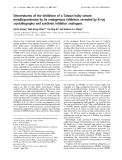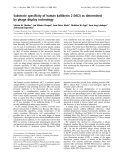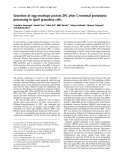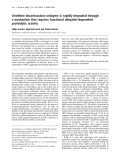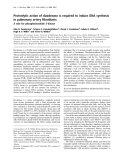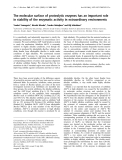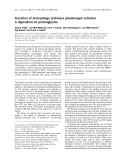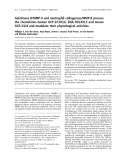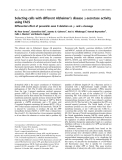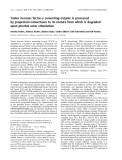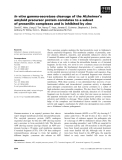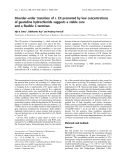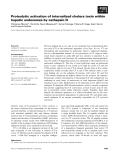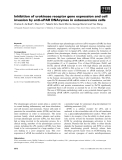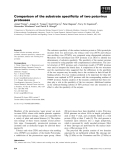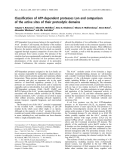
Proteolytic
-
Venoms from crotalid and viperid snakes contain several peptide inhibitors which regulate the proteolytic activities of their snake-venom metalloproteinases (SVMPs) in a reversible manner under physiological conditions. In this report, we describe the high-resolution crystal structures of a SVMP, TM-3, from Taiwan habu (Trimeresurus mucrosquamatus) cocrystallized with the endogenous inhibitors pyroGlu-Asn-Trp (pENW), pyroGlu-Gln-Trp (pEQW) or pyroGlu-Lys-Trp (pEKW).
 10p
10p  system191
system191
 01-06-2013
01-06-2013
 30
30
 5
5
 Download
Download
-
Human glandular kallikrein 2 (hK2) is a trypsin-like serine protease expressed predominantly in the prostate epithelium. Recently, hK2 has proven to be a useful marker that can be used in combination with prostate specific antigen for screening and diagnosis of prostate cancer. The cleavage by hK2 of certain substrates in the proteolytic cascade suggest that the kallikrein may be involved in prostate cancer development; however, there has been very little other progress toward its biochemical characterization or elucidation of its true physiological role.
 8p
8p  system191
system191
 01-06-2013
01-06-2013
 45
45
 2
2
 Download
Download
-
Murine pregnancy-associated plasma protein-A (PAPP-A) cDNA encoding a 1545 amino-acid protein has been cloned. We have also identified and cloned cDNA that encodes a novel variant of PAPP-A, PAPP-Ai, carrying a 29-residue highly basic insert. The point of insertion corresponds to a junction between two exons in the human PAPP-A gene. The human intron flanked by these exons does not encode a homologous corresponding insert, which is unique to the mouse.
 10p
10p  research12
research12
 01-06-2013
01-06-2013
 42
42
 6
6
 Download
Download
-
In avian species, an egg envelope homologous to the mammalian zona pellucida is called the perivitelline membrane. We have previously reported that one of its components, a glycoprotein homologous to mammalian ZPC, is synthesized in the granulosa cells of the quail ovary. In the present study, we investigated the proteolytic cleavage of the newly synthesized ZPC and the secretion of ZPC from the granulosa cells. Western blot analysis of the cell lysates demonstrated that the 43-kDa protein is the precursor of mature ZPC (proZPC), and is converted to the 35-kDa protein before secretion. ...
 9p
9p  research12
research12
 01-06-2013
01-06-2013
 36
36
 4
4
 Download
Download
-
Antizyme is a polyamine-induced cellular protein that binds to ornithine decarboxylase (ODC), and targets it to rapid ubiquitin-independent degradation by the 26S proteasome. However, the metabolic fate of antizyme is not clear. We have tested the stability of antizyme in mammalian cells. In contrast with previous studies demonstrating stability in vitro in a reticulocyte lysate-based degradation system, in cells antizyme is rapidly degraded and this degradation is inhibited by specific proteasome inhibitors. ...
 7p
7p  research12
research12
 01-06-2013
01-06-2013
 40
40
 3
3
 Download
Download
-
Duodenase is a 29-kDa serine endopeptidase that displays selective trypsin- and chymotrypsin-like substrate specificity. This enzyme has been localized to epitheliocytes of Brunner’s glands, and as described here, to mast cells within the intestinal mucosa and lungworm-infected lung, implying an important additional role in inflammation and tissue remodelling. In primary cultures of pulmonary artery fibroblasts, duodenase induced a concentration-dependent increase in [3H]thymidine incorporation with a maximal effect observed at 30 nM.
 10p
10p  research12
research12
 01-06-2013
01-06-2013
 54
54
 3
3
 Download
Download
-
It is scientifically and industrially important 1 to clarify the stabilizing mechanism of proteases in extraordinary envi-ronments. We used subtilisins ALPI and Sendai as models to study the mechanism. Subtilisin ALPI is extremely sensitive to highly alkaline conditions, even though the enzyme is produced by alkalophilicBacillus, whereas sub-tilisin Sendai from alkalophilic Bacillusis stable under conditions of high alkalinity.
 9p
9p  research12
research12
 23-04-2013
23-04-2013
 44
44
 1
1
 Download
Download
-
The large intestine of breast-fed infants is colonized predominantly by bi®dobacteria, which have a protective eect against acute diarrhea. In this study we report for the ®rst time the identi®cation of human milk peptides that selectively stimulate the growth of bi®dobacteria. Several bi®dogenicpeptideswerepuri®edchromatographically from pepsin-treated human milk and identi®ed as proteolytically generated fragments from the secretory component of the soluble polyimmunoglobulin receptor and lactoferrin;...
 7p
7p  research12
research12
 23-04-2013
23-04-2013
 45
45
 2
2
 Download
Download
-
The importance of proteoglycans for secretionof proteolytic enzymes was studied in the murine macrophage cell line J774. Untreated or 4b-phorbol 12-myristate 13-acetate (PMA)-stimulated macrophages were treated with hexyl-b-D-thioxyloside to interfere with the attachment of glycosaminoglycan chains to their respective protein cores. Activation of the J774 macrophages with PMA resulted in increased secretion of trypsin-like serine proteinase activity.
 10p
10p  tumor12
tumor12
 20-04-2013
20-04-2013
 34
34
 3
3
 Download
Download
-
On chemokine stimulation, leucocytes produce and secrete proteolytic enzymes for innate immunedefencemechanisms. Some of these proteasesmodify the biological activity of the chemokines. For instance, neutrophils secrete gelatinase B (matrix metalloproteinase-9, MMP-9) and neutrophil col-lagenase (MMP-8) after stimulation with interleukin-8/ CXCL8 (IL-8). Gelatinase B cleaves and potentiates IL-8, generating a positive feedback.
 11p
11p  tumor12
tumor12
 20-04-2013
20-04-2013
 69
69
 4
4
 Download
Download
-
The ultimate step in Alzheimer’s disease Abgeneration involves c-secretase, which releases Abfrom its membrane-bound precursor. Asimilar presenilin-dependent proteolytic activity is implicated in the release of theNotch intracellular domain. We have developed a novel assay forc-secretase activity based on green fluorescent protein detection. This involves cotransfection of a substrate-activator based on the amyloid precursor protein or the Notch sequence and a fluorescent reporter gene.
 12p
12p  tumor12
tumor12
 20-04-2013
20-04-2013
 31
31
 4
4
 Download
Download
-
Macrophages at an inflammatory site release massive amounts of proteolytic enzymes, including lysosomal cys-teine proteases, which colocalizewith their circulating, tight-binding inhibitors (cystatins, kininogens), so modifying the protease/antiprotease equilibrium in favor of enhanced proteolysis. We have explored the ability of human cath-epsins B, KandL to participate in the production of kinins, using kininogens and synthetic peptides that mimic the insertion sites of bradykinin on human kininogens....
 8p
8p  tumor12
tumor12
 20-04-2013
20-04-2013
 44
44
 5
5
 Download
Download
-
Tumor necrosis factor-a converting enzyme (TACE or ADAM17) is a member of the ADAM (a disintegrin and metalloproteinase) family of type I membrane proteins and mediates the ectodomain shedding of various membrane-anchored signaling and adhesion proteins. TACE is syn-thesized as an inactive zymogen, which is subsequently proteolytically processed to the catalytically active form.We have identified the proprotein-convertases PC7 and furin to be involved in maturation of TACE.
 8p
8p  fptmusic
fptmusic
 16-04-2013
16-04-2013
 37
37
 3
3
 Download
Download
-
Thec-secretase complex mediates the final proteolytic event in Alzheimer’s disease amyloid-bbiogenesis. This membrane complex of presenilin, ante-rior pharynx defective, nicastrin, and presenilin enhancer-2 cleaves the C-terminal 99-amino acid fragment of the amyloid precursor protein intra-membranously atc-sites to form C-terminally heterogeneous amyloid-b and cleaves at ane-site to release the intracellular domain or e-C-terminal fragment.
 14p
14p  fptmusic
fptmusic
 12-04-2013
12-04-2013
 39
39
 5
5
 Download
Download
-
The CII protein of bacteriophagek, which activates the synthesis of thekrepressor, plays a key role in the lysis– lysogeny switch. CII has a small in vivo half-life due to its proteolytic susceptibility, and this instability is a key com-ponent for its regulatory role. The structural basis of this instability is not known. While studying guanidine hydro-chloride-assisted unfolding of CII, we found that low concentrations of the chaotrope (50–500 mM) have a con-siderable effect on the structure of this protein.
 8p
8p  fptmusic
fptmusic
 12-04-2013
12-04-2013
 37
37
 2
2
 Download
Download
-
We have defined thein vivo andin vitro metabolic fate of internalized chol-era toxin (CT) in the endosomal apparatus of rat liver. In vivo, CT was internalized and accumulated in endosomes where it underwent degrada-tion in a pH-dependent manner. In vitro proteolysis of CT using an endo-somal lysate required an acidic pH and was sensitive to pepstatin A, an inhibitor of aspartic acid proteases.
 13p
13p  fptmusic
fptmusic
 11-04-2013
11-04-2013
 35
35
 3
3
 Download
Download
-
The urokinase-type plasminogen activator (uPA) receptor (uPAR) has been implicated in signal transduction and biological processes including cancer metastasis, angiogenesis, cell migration, and wound healing. It is a specific cell surface receptor for its ligand uPA, which catalyzes the formation of plasmin from plasminogen, thereby activating the proteolytic cascade that contributes to the breakdown of extracellular matrix, a key step in cancer metastasis.
 11p
11p  fptmusic
fptmusic
 11-04-2013
11-04-2013
 46
46
 3
3
 Download
Download
-
Botulinum neurotoxin type A (BoNT⁄A), the most toxic substance known to mankind, is produced by Clostridium botulinumtype A as a complex with a group of neurotoxin-associated proteins (NAPs) through polycis-tronic expression of a clustered group of genes. NAPs are known to protect BoNT against adverse environmental conditions and proteolytic digestion. Hemagglutinin-33 (Hn-33) is a 33 kDa subcomponent of NAPs that is resistant to protease digestion, a feature likely to be involved in the protec-tion of the botulinum neurotoxin from proteolysis. ...
 10p
10p  awards
awards
 06-04-2013
06-04-2013
 32
32
 3
3
 Download
Download
-
The substrate specificity of the nuclear inclusion protein a (NIa) proteolytic enzymes from two potyviruses, the tobacco etch virus (TEV) and tobacco vein mottling virus (TVMV), was compared using oligopeptide substrates. Mutations were introduced into TEV protease in an effort to identify key determinants of substrate specificity. The specificity of the mutant enzymes was assessed by using peptides with complementary substitutions. The crys-tal structure of TEV protease and a homology model of TVMV protease were used to interpret the kinetic data....
 0p
0p  awards
awards
 05-04-2013
05-04-2013
 36
36
 2
2
 Download
Download
-
ATP-dependent Lon proteases belong to the superfamily of AAA + proteins. Until recently, the identity of the residues involved in their proteolytic active sites was not elucidated. However, the putative catalytic Ser–Lys dyad was recently suggested through sequence comparison of more than 100 Lon proteases from various sources. The presence of the catalytic dyadwas experimentally confirmedby site-directed mutagenesis of theEscherichia coliLon protease and by determination of the crystal structure of its proteolytic domain.
 0p
0p  awards
awards
 05-04-2013
05-04-2013
 38
38
 2
2
 Download
Download
CHỦ ĐỀ BẠN MUỐN TÌM









